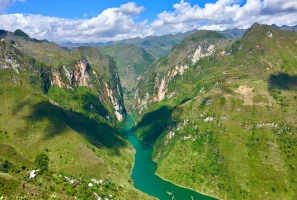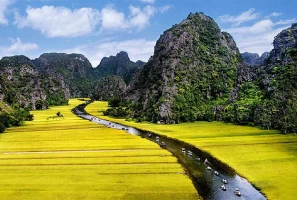Tết Nguyên Đán, the Vietnamese New Year, is a vibrant celebration that brings families together to honor ancestors, share well-wishes, and enjoy cherished traditions. With Frontier Travel, you'll experience the heart of the festivities, from wrapping sticky rice cakes to tasting delicious holiday dishes. The warm, rich cultural heritage of Vietnamese Tết creates unforgettable memories for all who take part!

1. What is the Vietnamese New Year?
The Vietnamese New Year, known as Tết Nguyên Đán or simply Tết, is the most important and widely celebrated holiday in Vietnam. It marks the beginning of the lunar new year and is a time for family reunions, paying respects to ancestors, and embracing fresh beginnings.
Tết typically falls between late January and mid-February, depending on the lunar calendar. During this festive period, people engage in various traditions such as cleaning and decorating homes, preparing special foods, exchanging red envelopes containing money, and visiting temples or pagodas to pray for good fortune in the coming year.
2. The origins of Vietnamese New Year?
The Vietnamese New Year originated from ancient agricultural societies in Vietnam, marking the end of the harvest season and the beginning of a new agricultural cycle. It was a time for farmers to rest, celebrate, and prepare for the upcoming planting season.
Tết also incorporates elements of Chinese culture, as Vietnam was under Chinese rule for over a thousand years. Over time, the celebration evolved to blend Vietnamese and Chinese customs, emphasizing family, ancestry, and new beginnings. Today, Tết remains the most significant holiday in Vietnam, preserving its rich cultural heritage.
3. How do Vietnamese people celebrate Vietnamese New Year?
Vietnamese people celebrate Tết with a variety of traditions and customs that honor their cultural heritage and usher in good fortune for the coming year.
Cleaning and decoration of houses
In the days leading up to Tết, Vietnamese families engage in a thorough cleaning of their homes, known as "tống cựu nghinh tân," which means "to send off the old and welcome the new." This ritual cleaning is believed to sweep away any bad luck or misfortune from the previous year and create a fresh, inviting space for the new year.
After cleaning, homes are decorated with vibrant flowers, such as peach blossoms in the North and apricot flowers in the South, symbolizing growth and prosperity. Other popular decorations include red and gold ornaments, paper cutouts, and calligraphic hangings, all of which contribute to the festive atmosphere.
Offerings for the Land Genie and the Kitchen God
In Vietnamese culture, the Land Genie and the Kitchen God are two important spiritual figures that are honored during Tết. The Land Genie is believed to protect the land and the household, while the Kitchen God is said to report the family's activities to the Jade Emperor in Heaven.
To express gratitude and seek blessings, Vietnamese families make offerings to these deities on the 23rd day of the 12th lunar month for the Kitchen God and on the eve of Tết for the Land Genie. Offerings typically include fruits, flowers, and traditional dishes such as sticky rice, boiled chicken, and votive papers.
Visiting Tet flower markets
Flower markets are a vibrant and essential part of Tết celebrations in Vietnam. In the days leading up to the festival, these markets spring up in cities and towns across the country, offering a wide variety of flowers, plants, and decorative items. People flock to these markets to purchase peach blossoms, apricot flowers, chrysanthemums, and kumquat trees, which are believed to bring good fortune and prosperity to households. The lively atmosphere, colorful displays, and bustling crowds make visiting Tết flower markets a cherished tradition and an exciting experience for both locals and visitors alike.
Arranging the five-fruit tray
The five-fruit tray, known as "mâm ngũ quả," is a symbolic arrangement that holds great significance during Tết celebrations. The tray typically features five different fruits, each carefully chosen for its auspicious meaning and arranged in an aesthetically pleasing manner. Common fruits include bananas for unity, oranges for wealth, pomelos for abundance, persimmons for joy, and apples for peace.
The number five is believed to represent the five elements of wood, fire, earth, metal, and water, as well as the five blessings of longevity, wealth, health, love of virtue, and a peaceful death. The five-fruit tray is placed on the family altar as an offering to ancestors and a symbol of the family's aspirations for the new year.
Preparing Banh Chung and Banh Day
Bánh chưng and bánh dày are two traditional Vietnamese rice cakes that are indispensable to Tết celebrations. Bánh chưng is a savory square cake made with glutinous rice, mung beans, and pork, wrapped in banana leaves and boiled for several hours. Bánh dày, on the other hand, is a round, sweet cake made with glutinous rice and filled with mung bean paste.
The preparation of these cakes is a time-honored tradition that brings family members together, as they gather to soak the rice, prepare the fillings, and wrap the cakes. The process is often accompanied by laughter, storytelling, and the sharing of memories, strengthening familial bonds and passing down cherished recipes from one generation to the next.
Sharing the blessings of Tet and lucky money
During Tết, one of the most cherished traditions is the exchange of red envelopes containing lucky money, known as "lì xì." Children and elderly family members are the primary recipients of these envelopes, which are believed to bring good luck and prosperity for the coming year.
The act of giving and receiving lì xì represents the sharing of blessings and well-wishes among loved ones. It is also common for employers to give lì xì to their employees as a token of appreciation and a wish for their success in the new year. The exchange of lucky money reinforces social bonds and promotes a sense of community and goodwill during this festive time.
Seeking calligraphic blessings
Calligraphy plays a significant role in Vietnamese Tết celebrations, as people seek out skilled calligraphers to create beautiful, meaningful works of art that convey blessings and aspirations for the new year. In the days leading up to Tết, calligraphers set up stalls in public spaces, such as temples, pagodas, or parks, where people can request custom-made calligraphic works.
People display these calligraphic works in their homes or offices, believing that they will bring good luck and positive energy throughout the year. The practice of seeking calligraphic blessings during Tết not only supports the continuation of this ancient art form but also serves as a reminder of the importance of culture, tradition, and shared hopes for the future.
Calligraphy paintings can also be bought as special souvenir gifts. Additionally, there are many other unique souvenirs in Vietnam that you can consider here.
4. What are the differences between regions during Vietnamese New Year?
The celebration of Vietnamese New Year varies somewhat across the different regions of Vietnam. While the core traditions and customs remain largely the same, each region has its own unique cultural elements and practices that contribute to the diverse tapestry of Tết celebrations.

Aspect | The North | The Central | The South |
Weather | Cool weather | Moderate weather | Warm weather |
Flowers | Peach blossoms (pink) | Apricot blossoms (yellow) | Apricot blossoms (yellow) |
Atmosphere | Quiet reverence, respect for traditions | Lively and colorful | Festive and vibrant |
Main food | Bánh chưng (square sticky rice cake) | Bánh tét (cylindrical sticky rice cake), mứt (candied fruit) | Thịt Kho Tàu (braised pork with eggs), bánh tét |
Games and activities | Traditional games and contests | Dragon dances, drum beats | Outdoor gatherings, picnics, flower markets |
Street decorations | Colorful decorations, temples, and pagodas | Elaborate flower displays, street decorations | Bustling flower markets, exuberant street performances |
Cities | Hanoi and other northern cities | Hue, Da Nang | Ho Chi Minh City, Mekong Delta |
Cultural heritage | Deep-rooted traditions, importance of family and community | Unique cultural heritage, famous for elaborate displays | Vibrant street performances, lion dances, firecrackers |
Tet holiday in the North
In the North, the cool weather and the vibrant pink of peach blossoms set the stage for a more traditional Tết experience. Families gather to make bánh chưng, a square sticky rice cake that is a staple of the holiday, and participate in age-old games and contests. The atmosphere is one of quiet reverence and respect for customs passed down through generations.
The streets of Hanoi and other northern cities are adorned with colorful decorations, and people flock to temples and pagodas to pray for good fortune in the coming year. The North's Tết celebrations are a testament to the region's deep-rooted traditions and the importance of family and community.
Tet holiday in the Central
As you journey to the Central region, the celebrations take on a more lively and colorful tone. Here, the streets are adorned with brilliant displays of apricot blossoms, their yellow petals dancing in the wind. The air is filled with the sounds of dragon dances and drumbeats, drawing crowds to witness the spectacle.
The cuisine of the Central region during Tết is a delightful fusion of flavors, with dishes like bánh tét and mứt offering a sweet and savory treat for the taste buds. Cities like Hue and Da Nang are particularly famous for their elaborate flower displays and street decorations, showcasing the region's unique cultural heritage.
Tet holiday in the South
Further south, in Ho Chi Minh City and the Mekong Delta, the warm weather and the golden hue of apricot blossoms create a festive ambiance that is uniquely Southern. The celebrations here are characterized by outdoor gatherings, such as picnics in the park and visits to bustling flower markets.
The cuisine is a reflection of the region's abundance, with dishes like thịt kho tàu and bánh tét taking center stage. The South is also known for its exuberant street performances, with lion dances and firecrackers adding a spark of excitement to the already lively atmosphere. The Tết celebrations in the South are a vibrant display of the region's warmth, hospitality, and zest for life.
5. Some festivals during Vietnamese New Year
During the Vietnamese New Year various festivals and events take place throughout the country, adding to the joyous atmosphere of the holiday. These celebrations showcase Vietnam's rich cultural heritage and bring communities together to welcome the new year.
Festivals in the North
The North of Vietnam comes alive during Tết with a host of traditional festivals that showcase the region's rich cultural heritage. One of the most notable is the Lim Festival in Bac Ninh province, where the mesmerizing melodies of Quan Ho folk singing, a UNESCO-recognized intangible cultural heritage, fill the air. Visitors can immerse themselves in the festive atmosphere, watching traditional games like cockfighting and wrestling, and savoring the flavors of local delicacies.
In the capital city of Hanoi, the Dong Da Festival commemorates the historic victory of Emperor Quang Trung over the Chinese Qing army in 1789. The streets come alive with a vibrant parade, as people dressed in colorful traditional costumes march through the city, carrying flags and banners. The festival is a testament to the resilience and spirit of the Vietnamese people, and a celebration of their proud history.
Festivals in the Central
As you head south to Vietnam's Central region, you'll find the celebrations take on a unique character. The Hue Festival, held in the historic imperial capital, happens every two years and highlights the area's rich cultural heritage. Traditional music, dance, and theater performances enchant audiences, while stunning fireworks light up the night. Visitors can join in traditional games and activities, fully experiencing the vibrant local culture.
Further down the coast, the Danang Fireworks Festival draws thousands of visitors each year to witness the dazzling displays over the Han River. The festival is a visual feast, with colorful fireworks illuminating the sky, accompanied by lively cultural performances and street parades. The Danang Fireworks Festival is a testament to the creativity and artistry of the Vietnamese people, and a celebration of the country's modern spirit.
Festivals in the South
In the bustling metropolis of Ho Chi Minh City, the Nguyen Hue Flower Street Festival transforms one of the city's main thoroughfares into a breathtaking display of color and life. Visitors can stroll along the street, admiring the vibrant flowers, lanterns, and decorations, while enjoying live music and dance performances. The festival is a celebration of the renewal and growth that Tết brings, and a symbol of the city's vibrant energy.
Another iconic festival in the South is the Ao Dai Festival, also held in Ho Chi Minh City. This celebration of the traditional Vietnamese dress showcases its beauty, elegance, and cultural significance through fashion shows, exhibitions, and performances. The festival is a tribute to the enduring legacy of Vietnamese culture, and a reminder of the importance of preserving and cherishing traditional values in an ever-changing world.
6. FAQ about Vietnamese New Year
As with any significant cultural event, there are many questions that arise about the customs, practices, and meanings behind Tết.
a. Are shops active during the Tet holiday?
During the Tết holiday, many shops and businesses in Vietnam close for several days to allow employees to spend time with their families and participate in the festivities. However, some essential services, such as hospitals, pharmacies, and certain convenience stores, may remain open with limited hours.
It's important to note that in major cities, some tourist-oriented shops and restaurants may continue to operate during Tết to cater to international visitors.
b. What are clothes suitable for Vietnamese New Year?
When it comes to dressing for Tết, Vietnamese people often opt for traditional and formal attire. Women typically wear the áo dài, a long, fitted silk tunic worn over loose-fitting trousers, while men may wear a simple version of the áo dài or a suit.
Bright colors, such as red, yellow, and purple, are favored during Tết as they are believed to bring good luck and prosperity. It's also common for people to purchase new clothing for the occasion as a symbol of a fresh start for the new year.
c. How long does Tet holiday last?
The official Tết holiday typically lasts for about a week, with the specific dates varying each year based on the lunar calendar. However, the celebrations and preparations leading up to Tết can begin weeks in advance, and the festive atmosphere may linger for several days after the official holiday period.
Many Vietnamese businesses and government offices close for the entire week, giving employees an extended break to travel, spend time with family, and participate in the various cultural traditions associated with Tết.
Celebrating Vietnamese New Year, or Tết Nguyên Đán, offers a unique and vibrant glimpse into Vietnam's rich cultural heritage. From traditional rituals to festive gatherings, Tết is the most significant and joyous occasion in the country. With guidance from Frontier Travel Vietnam, you can fully immerse yourself in these traditions and create unforgettable memories. Embrace the spirit of Tết and experience the heart of Vietnamese culture.


























